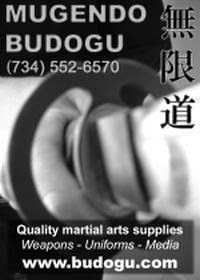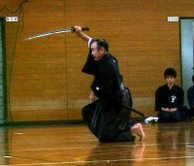A friend of mine asked about swords. He was wondering which was a better investment for iaido practice, a sword made of high quality modern steel or one made in the traditional fashion. I think he may have been surprised at my answer.
"Best for what?" For iai practice, you don't even need a sword made of steel. A well-balanced, well constructed iaito made of zinc-aluminium alloy will do just fine. The problem with many modern “samurai swords” is that they have the balance of crow bar. For classical Japanese sword training like iaido, the most important thing is the construction and balance of the sword. Bad balance or poor construction makes it impossible to learn good technique and can actually injure your arms. Poorly balanced swords put stress on your arms in ways that can damage them..
The best Japanese swords are still the ones made by classically trained smiths. This is because the classically trained smiths understand sword design, geometry and balance in depth. They've studied hundred of great blades and know what shapes are good for different applications and uses. Western made "samurai swords" look vaguely like a Japanese sword, but they generally lack the real character and traits that make a sword of a particular style or era that was designed for real use.
It's less about the particular steel than the geometry and balance. Modern steels are great. They are strong, resilient, inexpensive and rust resistant. Classically made, folded steel is expensive, strong, resilient and rusts if you look at it wrong. The real difference for practice is what the smith does with it. For that, the classically trained smith is hands down the best. Good iaito are made to mimic the weight, geometry and balance blades made by traditionally trained Japanese smiths, which is why they make the best investment for immediate practice.
This sword discussion reminds me a lot of my thoughts whenever someone asks me what the best martial art is. “Best for what?” What you want to do with the martial art will determine where the answer goes. Martial arts have as many differences as they do similarities. What’s best is going to depend on what you want out of it. Unfortunately, becoming an unbeatable super warrior isn’t something any art can give. Give some realistic thought to what you want. Is it unarmed or armed skills? Primarily physical or more mental? Do you want to sweat heavily, or only moderately (not sweating is not an option when learning martial arts)? Lots of contact or not?
While I am an unabashed fan classical Japanese koryu budo, they aren’t best for everyone. One reason is related to why my friend was asking about the difference between swords made with modern steel and those made by classically trained smiths: the cost to acquire one!
Genuine koryu budo are rare, even in Japan. In the USA where I live, they are exceptionally rare. I can count the number dojo teaching real koryu within a 2 hour drive of my home on my fingers. There are a couple of iai dojo, a jujutsu and kenjutsu ryuha, and my dojo with iai and jo. That’s it, and in a lot of places there aren’t even this many dojo. What this scarcity means is that learning real koryu budo is expensive. It means investing a lot of time and money just to get to someplace where you can learn one. Even then, there’s a good chance that what’s available isn’t exactly what you’re looking for.
Iai is great, but if you’re looking for kenjutsu or bojutsu or jujutsu, it’s not going to do you much good if the only things around are iai dojo. To really study something, you are probably going to have to travel a lot further than 2 hours. I teach Shinto Muso Ryu and Shinto Hatakage Ryu, but if I want to get instruction for myself, I have to go to where my teachers are. Japan. That’s the only real solution, and it’s not cheap. I’m lucky enough to be able to do it once or twice a year.
What happens if you can’t afford to travel an hour or more each way to practice, or worse, have to fly somewhere to receive hands on instruction? Koryu budo doesn’t look like a great option. On the other hand, the faux koryu stuff floating around is kind of like the faux “samurai swords.” It may look vaguely like the real thing, but under close examination it will lack many of the characteristics of a genuine koryu budo, and when you try to pick it up and use it, you may discover that it has the balance of a crow bar.
 |
I love koryu budo, but good quality gendai (modern) budo is great too. The metaphor above breaks down a little here, because gendai budo isn’t an attempt to mimic koryu budo the way an iaito mimics a shinken. Gendai budo were created to suit the ages of their founding, and have evolved since then. They aren’t koryu budo. Good gendai budo don’t try to be. Good gendai budo are honest about their age and qualities and history. Judo or aikido or kendo will teach a lot of the same things that you learn in a koryu budo. You’ll learn good structure, breathing, movement, spacing and timing. It won’t have the history or breadth of koryu budo, but it still has a huge amount to teach you.
If you want to learn good budo, do something that will teach you good fundamentals. I’m fond of saying there are no advanced techniques. There aren’t, and anything that is too specialized, too focused on a particular precise application, won’t be broadly applicable in new situations. A good foundation of understanding your body, structure, breathing, spacing and timing can be quickly adapted and applied to any new situation or study.
Koryu budo are still rare. If you aren’t lucky enough to live near where one is taught, then it’s probably not the best budo for you. I love koryu budo, but if nothing is available, then the best budo for you is probably something that is. I’ve found old Japanese swords in antique shops in the middle of nowhere, but they usually aren’t very good and often have fatal flaws such as deep rust or, worst of all, cracks that make the blade useless. Good judo or karate or aikido or kendo, whatever you can find, go in with eyes open. Just because someone has high rank or a teaching license, there is no guarantee that they are good teachers.
It’s better to learn good quality basics from a relatively low ranked and effective teacher than it is to learn poor quality advanced technique from a highly ranked person who has no teaching skills. It’s better to learn good fundamentals from a good, local, budo teacher than it is to bemoan the fact that you can’t afford to travel to where the art you dream of is taught. Start with an iaito and learn the fundamentals while you save to buy a shinken. Learn good budo fundamentals in a local dojo while you can. When you finally save enough for that beautiful shinken, all the training with the iaito will mean that you can handle it with confidence and safety. All that training in the fundamentals of structure and spacing and timing in the local budo dojo will mean that when it becomes possible to start studying the art you’ve been dreaming of, you’ll already have a solid foundation to build on, instead of having to start completely from scratch.






